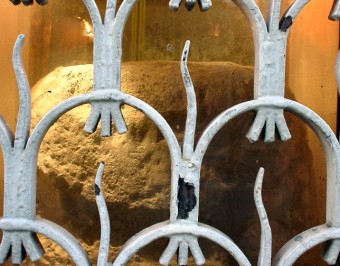The Ancient Stone in London That Is Supposed to Be Important But No One Remembers Why
 Sitting in the heart of London since long before anyone can remember, theories regarding the London Stone range from Roman ruin, to Druidic icon to a talisman of good fortune.
Sitting in the heart of London since long before anyone can remember, theories regarding the London Stone range from Roman ruin, to Druidic icon to a talisman of good fortune.
Although many point to John Stow’s Survey of London (1598), where he sets the 10th century as the first mention of the stone in print (he claims he found a mention of the stone in a document from the 900s AD), others feel more comfortable citing a list of Canterbury Cathedral’s properties from somewhere around the turn of the 12th centuries, where it lists Eadwaker æt lundene stane.
Regardless, by medieval times, the London Stone was a fixture in the city, so much so that residents even incorporated it into their names, such as Ailwin of London Stone. Clearly important, by the 15th century the landmark was seen as a symbol for London, and perhaps England; this helps explain why, when Jack Cade led a rebellion against Henry VI in 1450, he reportedly struck the London Stone with his sword in claiming the city for himself, as immortalized by Shakespeare in King Henry VI, Part II, Act IV, Scene VI.
In the 16th century, one popular theory for the stone’s origins was that it had been used by the Roman’s during their occupation (approximately 43 AD – 410 AD) as a millarium or central milestone from which all distances were measured. Charles Dickens even cited this explanation in his Dictionary of London (1879).
During the 18th century, some were speculating that the stone was used in worship by the Druids, although there is no evidence to support it.
In the 19th century, as interest in spiritualism became more widespread, some theorized that the London Stone was a Palladium or talisman dating back to Roman times and Britain’s legendary founder. It was during this time that the now well-known saying appeared: “So long as the Stone of Brutus is safe, so long shall London flourish.”
By the 20th century, serious archaeologists began digging into the London Stone’s origins, and some found that it is situated at the center, or at the gate, of where a large Roman structure, sometimes identified as a Governor’s palace or pretorium, had been.
Today, those who believe in ley lines, straight “lines” that connect sites of historical or geographical significance, claim that the London Stone is transected by several of these lines, while others have posited that the stone was set in the center of the old Roman city, in homage to Jupiter.
If you liked this article, you might also enjoy our new popular podcast, The BrainFood Show (iTunes, Spotify, Google Play Music, Feed), as well as:
- The Truth About the Bermuda Triangle
- How Hieroglyphics were Originally Translated
- The Mystery of Gobekli Tepe
- How Things Become Petrified
- The Mystery of the Coral Castle
Bonus Facts:
- Since about 10,000 years ago, people have inhabited the area around Salisbury, England known as Stonehenge. Dating to as far back as 7,500 BC, flint tools and fragments have been found, and other archaeological evidence points to relatively continuous habitation since then.
- From about 3,500 BC, people in the region were building monuments, beginning with earthworks at least one of which was nearly two miles long, with pits at its east and west ends. Shortly after, about 3,000 BC, the ancient builders drilled postholes, although it’s not clear if the first holes were used for timber posts or bluestones. Regardless, by 2,600 BC, two circles of bluestones were raised at the site.
- By 2,400 BC, a horseshoe-shaped monument of sarsen stones was erected in the center of a ring of similar stones with stone lintels that connected them. Within a century, a ring of bluestone rings was raised inside the horseshoe, and another in between it and the outer ring of sarsen stones.
- The “heel stone” of Stonehenge aligns with the pits of the older, long earthen monument. These pits, in turn, are aligned with the sunset and sunrise of the Summer solstice.
- Remarkably, the bluestones, which weigh as much as four tons, were originally from Wales and were somehow transported the more than 140 miles to Salisbury. Some think the stones were moved by ancient people using rafts, and others theorize ice age glaciers may have moved them.
- The sacren stones are even larger, weighing up to 25 tons (and standing as high as 30 feet) and were somehow transported from Marlborough Downs, 20 miles to the north.
- Henge has been defined as a ditch inside an earthen bank with at least one entrance through the bank. Ironically, since Stonehenge has its bank inside the ditch, it may not technically be a henge, but rather a stone circle.
- Britain is dotted with stone circles and henges, with the former numbering about 1,000, and the latter about 120, which, if my calculations are correct, is one ancient monument for every 80 square miles.
- Cecil Chubb was the last person to own Stonehenge, purchasing it in 1915 on a whim for about the equivalent of $800,000 today. According to the BBC, he gave it to his wife as a gift, which she in turn didn’t appreciate. Three years later, he donated it to England.
| Share the Knowledge! |
|





The truth of the stone’s origin are much more sinister. Around 200 AD (The remainder of this post has been deleted by the Illuminati)